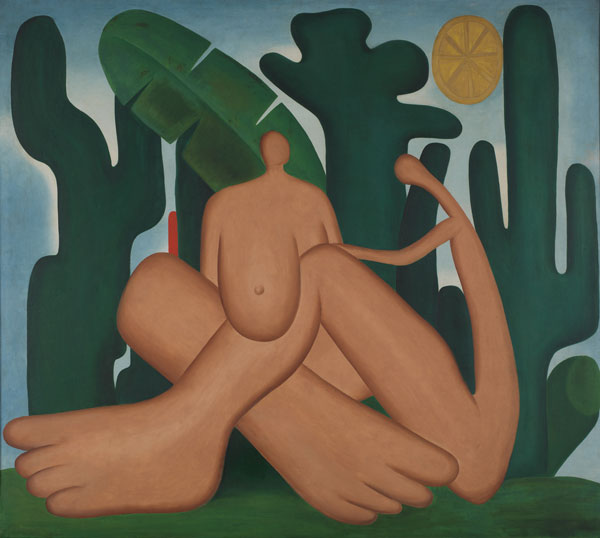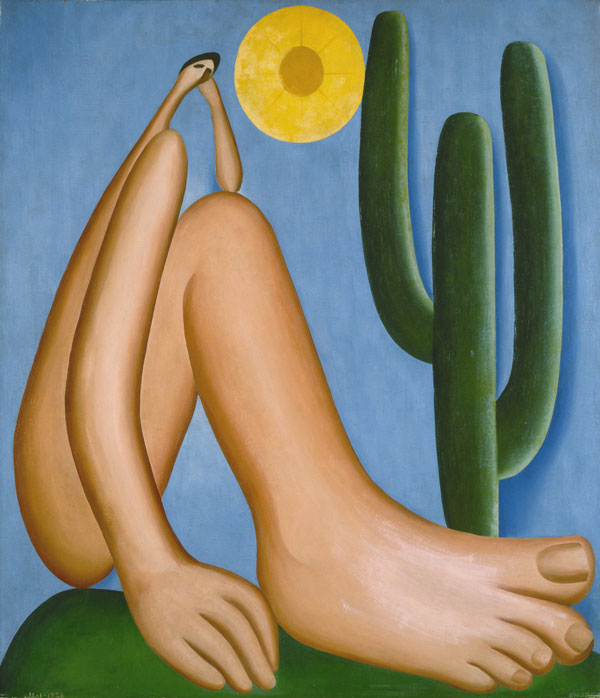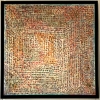THE FIRST MAJOR U.S. MUSEUM EXHIBITION OF TARSILA DO AMARAL
CELEBRATES THE ARTIST’S PIONEERING WORK AND LASTING INFLUENCETarsila do Amaral: Inventing Modern Art in Brazil
February 11–June 3, 2018
Floor 2, The Paul J. Sachs Galleries
The Museum of Modern Art
11 West 53 Street,
New York, NY 10019With Tarsila do Amaral: Inventing Modern Art in Brazil, The Museum of Modern Art presents the first monographic exhibition in the United States exclusively devoted to the pioneering work of Tarsila do Amaral (Brazilian, 1886–1973), a founding figure of Brazilian modernism. On view February 11 through June 3, 2018, the exhibition focuses on the artist’s production from the 1920s, tracing the path of her
groundbreaking contributions through approximately 120 works, including paintings, drawings, sketchbooks, and photographs drawn from collections across the US, Latin America, and Europe. Tarsila do Amaral: Inventing Modern Art in Brazil is organized by The Museum of Modern Art and the Art Institute of Chicago, by Luis Pérez-Oramas, former Estrellita Brodsky Curator of Latin American Art, The Museum of Modern Art, and Stephanie D’Alessandro, former Gary C. and Frances Comer Curator of International Modern Art, the Art Institute of Chicago; with Karen Grimson, Curatorial Assistant, Department of Drawings and Prints, The Museum of Modern Art. Prior to its presentation in New York, the exhibition was on view at the Art Institute of Chicago from October 8, 2017, through January 7, 2018.
Tarsila do Amaral: Inventing Modern Art in Brazil explores the radical vision of an artist who profoundly shaped modernist practice in Brazil, and was a key figure for subsequent generations of Brazilian artists working across media, from literature and theater to fashion and music. A long-overdue introduction to this major Brazilian modernist for North American audiences, the exhibition will survey Tarsila’s career from her earliest Parisian works to the emblematic modernist paintings produced upon her return to Brazil, ending with her large-scale, socially driven works of the early 1930s. Central to the exhibition is the reunion of three landmark paintings: The Black Woman (1923), Abaporu (1928), and Anthropophagy (1929), a transformational series of works that were last exhibited jointly in North America as part of the MoMA exhibition Latin American Artists of the Twentieth Century in 1993.Tarsila do Amaral. Abaporu, 1928. Oil on canvas.
33 7/16 x 28 3/4 in. (85 x 73 cm). Collection MALBA,
Museo de Arte Latinoamericano de Buenos Aires.
© Tarsila do Amaral Licenciamentos.
| Born in 1886 in the rural town of Capivari, on the outskirts of São Paulo, Tarsila—as she is affectionately known in Brazil—was raised among the plantation-owning bourgeoisie. Traveling in cosmopolitan circles between São Paulo and Paris, she enrolled at the Académie Julian, a Parisian art school that drew many international students. 1922–1927: São-Paulo to Paris, and Back Tarsila was notably absent during the run of the seminal Semana de Arte Moderna (Modern Art Week) in São Paulo, in February of 1922. Back in Brazil in June 1922, her friend, the artist Anita Malfatti, introduced Tarsila to the core group behind the modernist movement: the poets Mário de Andrade, Paulo Menotti del Picchia, and Oswald de Andrade, the latter of whom was immediately mesmerized by Tarsila. Together they formed Grupo dos Cinco (Group of Five), a rambunctious, galvanizing coterie that discussed poetry and the state of the arts in Brazil. By the end of the year, Tarsila went back to Paris, where De Andrade joined her. |
 |
| Tarsila do Amaral. Anthropophagy (Antropofagia), 1929. Oil on canvas. 49 5/8 x 55 15/16 in. (126 x 142 cm). Acervo da Fundação Jose e Paulina Nemirovsky, em comodato com a Pinacoteca do Estado de São Paulo. © Tarsila do Amaral Licenciamentos. |
| Throughout 1923, Tarsila studied in the studios of French Cubist masters such as André Lhote, Albert Gleizes, and Fernand Léger. These apprenticeships led her to conclude that “Cubism is the artist’s military service. All artists must experience it to get strong.” Integrating her new knowledge, she began to formulate what would become her signature style of painting, employing synthetic lines, sensuous volumes, and a rich color palette to depict landscapes and genre scenes. In a letter to her family that year she wrote, “I feel increasingly Brazilian: I want to be the painter of my country. … In art, I want to be the caipirinha [country girl] of São Bernardo.” The painting The Black Woman from that year, on view in the exhibition, suggests these ambitions. Returning to Brazil in 1923, Tarsila sought inspiration from her country, its landscape and people, blending the innovations of the European avant-garde with a Brazilian vernacular sensibility to produce a distinctive body of work that was as personal as it was novel. |
| In February 1924 Tarsila and De Andrade traveled with the Swiss poet Blaise Cendrars to Rio de Janeiro to attend the carnival festivities. During this trip, Tarsila sketched the drawings that would illustrate Cendrars’s Feuilles de route, which was published that year in Paris with a drawing of Tarsila’s Black Woman on the cover. At this time, she also painted Carnival in Madureira and A Cuca, which she described as “a very Brazilian painting.” In April 1924, she traveled with De Andrade, Cendrars, and others to Minas Gerais, visiting colonial towns along the way to the state’s capital, Belo Horizonte. The exhibition includes a selection of Tarsila’s many sketches from this trip, some of which resulted in later paintings such as Lagoa Santa, which is also on view. Oswald’s “Manifesto of Pau-Brasil Poetry,” which had first appeared in print a month prior, in an issue of the newspaper Correio da Manhã, called for a renewal of language, promoting a return to its primitive state. Tarsila’s production from this period, known as her Pau-Brasil phase, is reflective of Oswald’s project. |
| In September Tarsila and De Andrade—baptized by Mário de Andrade as “Tarsiwald”—returned to Paris, and they were engaged by the end of year. Following Tarsila’s first solo exhibition, at the Parisian Galerie Percier in June 1926, and a trip to the Middle East, Tarsila and De Andrade were married on October 30, 1926, and settled back in São Paulo. Living between the farm and the city, Tarsila’s paintings took on a more dreamlike tone (as seen in Sleep, 1928) and an increasingly surrealist bent (Urutu, 1928). |
 |
| Tarsila do Amaral. Urutu Viper (Urutu). 1928. Oil on canvas. 23 5/8 x 28 3/8 in. (60 x 72 cm). Coleção Gilberto Chateaubriand, Museu de Arte Moderna, Rio de Janeiro. © Tarsila do Amaral Licenciamentos. |
Anthropophagy and Beyond |
|
One of the central works in the exhibition is Abaporu, which Tarsila painted in 1928 for De Andrade, depicting an elongated figure with a blooming cactus. The title combines two words from the language of the Tupi-Guarani Indians: aba (man) and poru (“who eats human flesh”). This painting inspired De Andrade to write the “Manifesto of Anthropophagy.” Published in May of that year in the inaugural issue of the Revue of Anthropophagy, Tarsila’s painting quickly became the banner for a transformative artistic movement that imagined a Brazilian culture arising from the symbolic digestion—or artistic “cannibalism”—of outside influences.
As Brazil sank into Getúlio Vargas’s nationalist dictatorial regime, Tarsila, captivated by the developments taking place in the Soviet Union, embraced Marxism. Together with her new partner, Osório César, she travelled to Russia, where she had a solo exhibition. On her return she was imprisoned for a month for being a leftist sympathizer. In the wake of this experience, Tarsila abandoned the imaginative depiction of nature for a more socially committed form of representation. One such example in the exhibition is Workers (1933), a group portrait of workers set against factory smokestacks, emphasizing the diversity of Brazilian society. By the 1960s and 1970s a younger generation of Brazilian artists (including Lygia Clark and Hélio Oiticica), followed by those artists associated with the Tropicália movement (such as the musicians Caetano Veloso and Gilberto Gil), rediscovered Anthropophagy and Tarsila’s art. |
SPONSORSHIP: |
|
Major support for the New York presentation is provided by The International Council of The Museum of Modern Art, The Modern Women’s Fund, and by the Vicky and Joseph Safra Foundation. Generous funding is provided by Clarice Oliveira Tavares, Yvonne Dadoo Ader, and by the Consulate General of Brazil in New York. Additional support is provided by the Annual Exhibition Fund. |
PUBLICATION: |
| The exhibition will be accompanied by a richly illustrated catalogue presenting Tarsila’s paintings, drawings, letters, and photographs and offering a full overview of this critical period in her career. Essays by Luis Pérez-Oramas and Stephanie D’Alessandro examine the artist’s production from the 1920s and her long-lasting legacy, and are accompanied by an illustrated documentary section, a translation of critical texts, a chronology, and an extensive bibliography. 192 pages, 176 color and eight black-and-white illustrations. Hardcover: $50. ISBN: 9780300228618. Published by the Art Institute of Chicago and distributed by Yale University Press. Available at MoMA Stores and online at store.moma.org. |
AUDIO TOUR: |
|
The audio tour accompanying this exhibition features commentary by exhibition curator Luis Pérez-Oramas and quotes from the artist. MoMA Audio is available for streaming and download on MoMA's free app on iTunes, at moma.org/audio, and free of charge at the Museum. MoMA Audio is supported by Bloomberg Philanthropies. |
MOMA CLASS: |
|
Introduction to Brazilian Modern Art Thursdays, March 15, 22, 29, and April 5, 7:00–8:50 p.m. Instructor: Karen Grimson This class offers an overview of the artists and artworks that radicalized the visual arts scene in Brazil during the first half of the 20th century. Focusing on the emergence of Brazilian modernism during the seminal Semana de Arte Moderna of 1922 in São Paulo, this class will take a chronological approach, drawing connections between the release of the “Manifesto Antropófago” in 1928 and the subsequent generation of artists who revived the movement’s influence in the 1950s and ’60s. Special attention will be paid to the history of Brazilian art exhibitions at The Museum of Modern Art—from the early monographic show on Cândido Portinari in 1940 to the most recent Lygia Clark retrospective of 2014—and the Museum’s holdings of Brazilian art. The class will include visits to the Museum’s galleries, including the exhibition Tarsila do Amaral: Inventing Modern Art in Brazil, and the Museum’s study centers, allowing participants to look closely at selected works pulled from storage especially for this class. For the full schedule and registration, visit moma.org/classes. Nonmember $355, Member $325, Student/Educator/Other Museum Staff $250 |
Public Information: |
|
The Museum of Modern Art, 11 West 53 Street, New York, NY 10019, (212) 708-9400, |


























